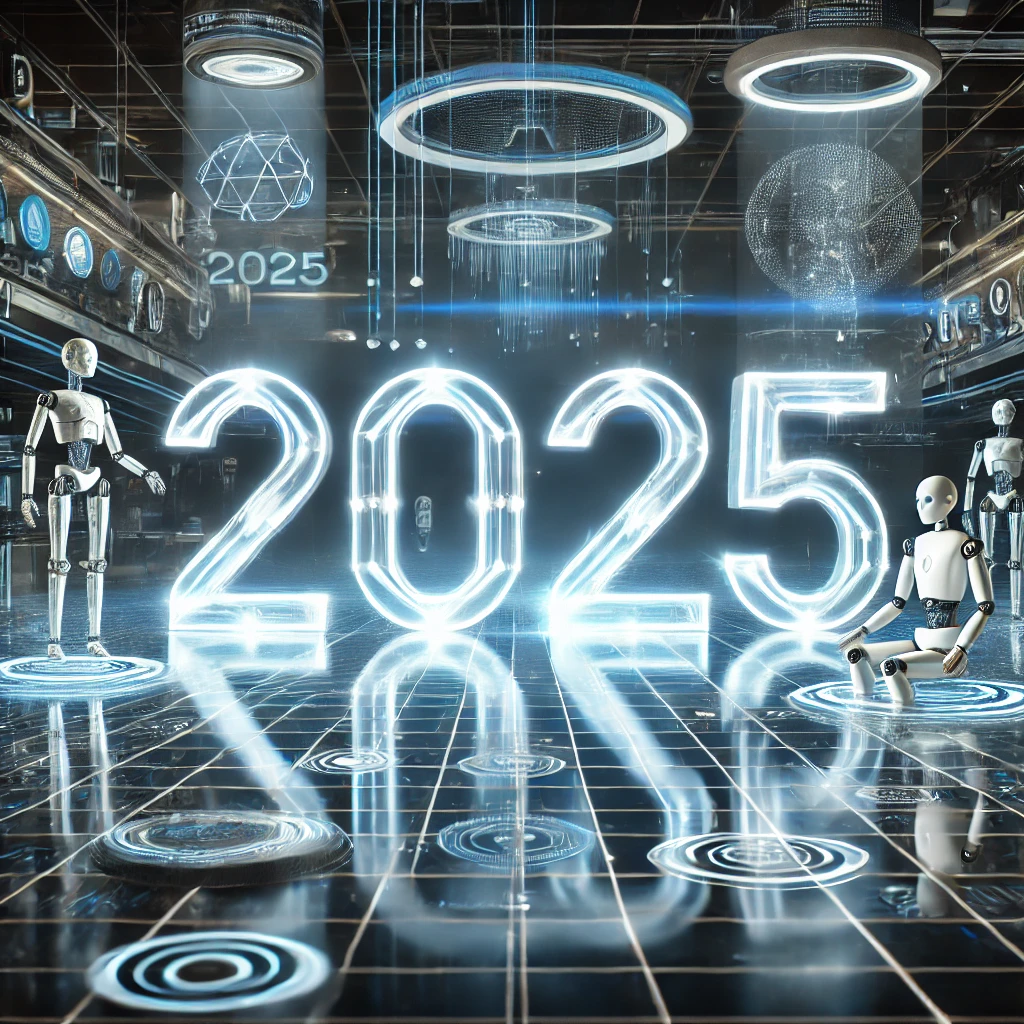Die wichtigsten Trends und Entwicklungen auf einen Blick
Das Jahr 2025 wird für die künstliche Intelligenz (KI) ein entscheidendes Jahr sein. Mit neuen Technologien, einer schnellen Verbreitung und bahnbrechenden Innovationen werden KI-Lösungen die Art und Weise, wie wir leben, arbeiten und Probleme lösen, revolutionieren. Dieser Artikel befasst sich mit den wichtigsten KI-Trends des Jahres 2025 und ihren Auswirkungen auf Wirtschaft, Gesellschaft und Technologie.
1. Personalisierung durch KI
Einer der vielversprechendsten Trends ist die wachsende Fähigkeit der KI, personalisierte Erfahrungen zu schaffen. Vom E-Commerce bis zum Gesundheits- und Bildungswesen wird KI eingesetzt, um maßgeschneiderte Lösungen anzubieten.
- E-Commerce: KI-gestützte Empfehlungsalgorithmen analysieren das Nutzerverhalten, um individualisierte Produktvorschläge zu machen.
- Gesundheitswesen: Personalisierte Behandlungspläne basieren auf KI-Analysen von Patientendaten, Genomik und Krankengeschichte. KI kann auch Präventionsmaßnahmen vorschlagen, die auf individuelle Risikoprofile zugeschnitten sind.
- Bildung: Adaptive Lernsysteme passen die Lerninhalte an die Bedürfnisse der einzelnen Schüler an und fördern so ein effektiveres Lernen. Diese Systeme können Lehrern und Eltern auch detaillierte Einblicke in die Fortschritte der Schüler geben.
2. Fortschritte in der generativen KI
Die generative KI, die Inhalte wie Texte, Bilder, Musik und Videos erstellt, wird 2025 weiter verfeinert werden. Technologien wie GPT-4 und DALL-E 3 ermöglichen neue kreative Anwendungen.
- Medien und Unterhaltung: Generative KI wird eingesetzt, um Filme, Musik und Kunst schneller und kostengünstiger zu produzieren. Streaming-Dienste könnten KI nutzen, um personalisierte Serien oder Filme zu erstellen.
- Erstellung von Inhalten: Unternehmen können die Erstellung hochwertiger Inhalte automatisieren und damit Marketing und Werbung revolutionieren. Auch kleinere Unternehmen erhalten Zugang zu professionellen Marketing-Ressourcen.
- Entwurf: Architekten und Produktdesigner nutzen KI, um innovative Entwürfe effizienter zu erstellen. Auch in der Modebranche wird generative KI zunehmend eingesetzt, um Trends vorherzusagen und Designs zu entwerfen.
3. Werden die Mitarbeiter durch KI ersetzt werden?
Eine der zentralen Fragen ist, ob KI Arbeitsplätze ersetzen wird. In Wirklichkeit ermöglichen KI-Lösungen den Unternehmen eine erhebliche Produktivitätssteigerung, ohne dass sie ihre Kernteams unbedingt erweitern müssen. Stattdessen werden bestehende Teams durch KI-Tools unterstützt, die sich wiederholende Aufgaben automatisieren, sodass sich die Mitarbeiter auf strategisch wichtige Tätigkeiten konzentrieren können.
Unternehmen könnten wachsen, ohne eine große Zahl neuer Mitarbeiter einzustellen. Dies führt jedoch nicht zwangsläufig zu Arbeitsplatzverlusten, sondern eher zu einer Umverteilung der Ressourcen auf komplexere und wertschöpfende Aufgaben.
4. Die Rolle der KI-Agenten
KI-Agenten werden im Jahr 2025 eine entscheidende Rolle spielen. Diese spezialisierten Systeme können als eigenständige Einheiten agieren und bestimmte Aufgaben effizient und zuverlässig erledigen. Sie arbeiten oft in Teams und kommunizieren miteinander, um komplexe Prozesse zu steuern. Diese Entwicklung könnte nicht nur die Produktivität steigern, sondern auch die Art und Weise, wie Unternehmen ihre internen Abläufe organisieren, grundlegend verändern.

5. Wie werden sich die Team- und Abteilungsstrukturen verändern?
Der Einsatz von KI wird Team- und Abteilungsstrukturen flexibler und dynamischer machen. KI kann dabei helfen, Arbeitsbelastungen zu analysieren und Aufgaben effizienter zu verteilen. Führungskräfte können sich zunehmend auf datengestützte Entscheidungen verlassen, während kleinere Teams spezialisierter und agiler werden.
Neue Rollen wie "KI-Koordinator" oder "Automatisierungsmanager" könnten entstehen, um die effektive Nutzung von KI-Technologien sicherzustellen. Je nach Größe und Branche des Unternehmens können sich unterschiedliche Rollenprofile entwickeln.
6. Anpassung der Technologie: Bestehende Lösungen besser nutzen
Viele Unternehmen verfügen bereits über KI-Tools, nutzen aber nur einen Bruchteil ihrer Möglichkeiten. Im Jahr 2025 wird sich der Schwerpunkt darauf verlagern, die vorhandenen Technologien besser anzupassen und sie vollständig in die Geschäftsstrategien zu integrieren. Schulungsprogramme und Change-Management-Initiativen werden eine Schlüsselrolle bei der Förderung der Akzeptanz und der effektiven Nutzung von KI spielen.
7. Einbettung von KI in die Unternehmensstrategie
KI wird zunehmend als strategisches Instrument betrachtet. Unternehmen, die KI erfolgreich in ihre langfristigen Ziele integrieren, können erhebliche Wettbewerbsvorteile erzielen. Dies erfordert jedoch eine klare Vision und die Bereitschaft, in Infrastruktur und Talente zu investieren.
8. AI-Manager als Standardrolle
Die Rolle des KI-Managers wird in mittelständischen Unternehmen immer wichtiger. Diese Fachleute sind dafür verantwortlich, die Implementierung und Nutzung von KI-Technologien zu beaufsichtigen, Datenstrategien zu entwickeln und sicherzustellen, dass KI ethisch korrekt und effektiv eingesetzt wird.
9. Neue Berufsbezeichnungen aufgrund der Einführung von KI
Die Einführung von KI schafft neue Berufsbezeichnungen. Beispiele sind "KI-Trainer", "KI-Ethikbeauftragter" oder "Automatisierungsspezialist". In großen Unternehmen können ganze Abteilungen entstehen, die sich ausschließlich mit der Entwicklung und Implementierung von KI-Lösungen beschäftigen.
10. Kleine Unternehmen sind die größten Gewinner
Kleine Unternehmen könnten im Jahr 2025 die größten Gewinner des KI-Booms sein. Dank skalierbarer und kosteneffizienter KI-Tools können sie Prozesse automatisieren und Dienstleistungen verbessern, ohne große Investitionen tätigen zu müssen. Diese Entwicklung könnte die Wettbewerbsfähigkeit kleinerer Unternehmen stärken.
11. Das EU-KI-Gesetz und regulatorische Aktualisierungen
Die Umsetzung des EU-KI-Gesetzes wird im Jahr 2025 ein zentrales Thema sein. Neue Regelungen sollen ethische Standards und Transparenz sicherstellen. Die Bundesregierung hat bis August Zeit, eine nationale Aufsichtsstruktur aufzubauen. Unternehmen müssen zudem sicherstellen, dass ihre Mitarbeiter im Umgang mit KI geschult sind, um die neuen Anforderungen zu erfüllen.
Die Einhaltung dieser Vorschriften wird entscheidend dafür sein, wie KI in Europa entwickelt und eingesetzt wird. Gleichzeitig könnten diese Vorschriften einen globalen Standard setzen und dazu beitragen, die verantwortungsvolle Nutzung der Technologie zu fördern.
Schlussfolgerung: Die Zukunft der KI ist jetzt
Die KI-Trends des Jahres 2025 zeigen, wie transformative Technologien unsere Welt gestalten. Unternehmen, die sich diese Innovationen frühzeitig zu eigen machen, können sich Wettbewerbsvorteile verschaffen und gleichzeitig einen Beitrag zur Lösung globaler Herausforderungen leisten. Mit Fortschritten in den Bereichen Personalisierung, Automatisierung und Ethik stehen wir an der Schwelle zu einer neuen Ära der Technologie. Gleichzeitig müssen Herausforderungen wie Regulierung, Ethik und wirtschaftliche Nachhaltigkeit angegangen werden, um das volle Potenzial der KI zu erschließen.







